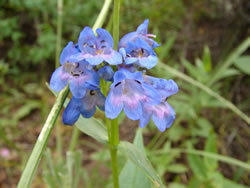Plant of the Week
 Penstemon rydbergii range map. USDA PLANTS Database.
Penstemon rydbergii range map. USDA PLANTS Database.
 Close-up of Penstemon rydbergii. Photo by Sherri Hagwood, Bureau of Land Management.
Close-up of Penstemon rydbergii. Photo by Sherri Hagwood, Bureau of Land Management.
 Inflorescence of Penstemon rydbergii. Photo by Sherri Hagwood, Bureau of Land Management.
Inflorescence of Penstemon rydbergii. Photo by Sherri Hagwood, Bureau of Land Management.
 Penstemon rydbergii in habit. Photo by Sherri Hagwood, Bureau of Land Management.
Penstemon rydbergii in habit. Photo by Sherri Hagwood, Bureau of Land Management.
Rydberg’s penstemon (Penstemon rydbergii)
By Walter Fertig
Penstemons or beardtongues (genus Penstemon of the figwort family or Scrophulariaceae) are among the showiest of the native wildflowers that grace the deserts, grasslands, forests, mountain meadows, and alpine tundra of western North America. With over 250 recognized species, Penstemon is the third largest genus of flowering plants found in the interior west, following Astragalus and Eriogonum. Penstemon flowers can range in color from white to pink, red, or purple, but the majority are bright blue and are characterized by a tubular corolla formed by the fusion of five petals. Superficially, the flowers of most Penstemon species are similar in outward appearance but differ greatly in the shape, degree of pubescence, and dehiscence of their anthers (the male, pollen-bearing structures inside of the flower). Penstemons have only four fertile, pollen-producing anthers, with the fifth anther modified into a sterile, often densely hairy, tongue-shaped appendage called a staminode (species with extremely hairy staminodes are often called beardtongues). Many books mistakenly translate the Latin name Penstemon as meaning “five stamens”, but this is incorrect. The “pen” in Penstemon comes not from penta (five) but from the Latin paene meaning “nearly” or “almost”, while stemon is derived from Greek for “thread”. “Nearly a thread” is a reference to the staminode, which is almost a functional stamen.
Among the more widespread of the purple beardtongues of western North America is Rydberg’s penstemon (P. rydbergii). It is equally at home in alpine meadows above treeline and valley bottoms and streamsides from Washington and Montana to central California, northern Arizona, and New Mexico. Rydberg’s penstemon has relatively small flowers (compared to other Penstemon species), but these are clustered in several dense, leafy whorls that interrupt the bare stem. The small flowers of P. rydbergii are apparently adapted for pollination by small bees that crawl into the corolla tube to drink nectar and pick up, transport, and deposit pollen in the process.
Rydberg’s penstemon is one of nearly two dozen plant species named in honor of Per Axel Rydberg, a prominent Swedish-American botanist of the late 19th and early 20th centuries. Although originally trained as a railroad engineer, an accident left Rydberg permanently lame and in search of a less strenuous occupation. Rydberg turned his amateur interest in botany into a second career, rising to prominence as the curator of the New York Botanical Garden herbarium and authoring several early floras of the Black Hills, Colorado, Montana, Rocky Mountains, and Great Plains.
Over his prolific botanical career, Rydberg described nearly 1400 new species and genera of vascular plants from North America, earning him a reputation as a taxonomic “splitter”, or someone who emphasizes morphological differences between plant populations (versus a “lumper”, or taxonomist who places greater importance on continuities among populations). Marcus Jones, one of Rydberg’s more acerbic contemporaries, accused him of “bughole botany,” of naming new species based on the number of bugholes on each specimen. In Rydberg’s defense, modern taxonomic concepts were still evolving in the early 20th century, and a large number of the taxa he named are still recognized, though often as varieties rather than full species.

